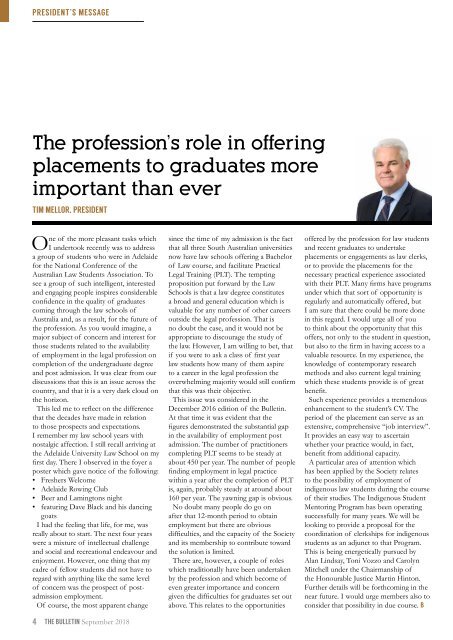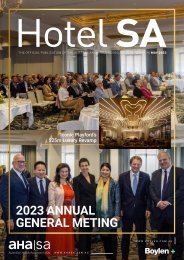LSB September 2018_Web
Create successful ePaper yourself
Turn your PDF publications into a flip-book with our unique Google optimized e-Paper software.
PRESIDENT’S MESSAGE<br />
The profession’s role in offering<br />
placements to graduates more<br />
important than ever<br />
TIM MELLOR, PRESIDENT<br />
One of the more pleasant tasks which<br />
I undertook recently was to address<br />
a group of students who were in Adelaide<br />
for the National Conference of the<br />
Australian Law Students Association. To<br />
see a group of such intelligent, interested<br />
and engaging people inspires considerable<br />
confidence in the quality of graduates<br />
coming through the law schools of<br />
Australia and, as a result, for the future of<br />
the profession. As you would imagine, a<br />
major subject of concern and interest for<br />
those students related to the availability<br />
of employment in the legal profession on<br />
completion of the undergraduate degree<br />
and post admission. It was clear from our<br />
discussions that this is an issue across the<br />
country, and that it is a very dark cloud on<br />
the horizon.<br />
This led me to reflect on the difference<br />
that the decades have made in relation<br />
to those prospects and expectations.<br />
I remember my law school years with<br />
nostalgic affection. I still recall arriving at<br />
the Adelaide University Law School on my<br />
first day. There I observed in the foyer a<br />
poster which gave notice of the following:<br />
• Freshers Welcome<br />
• Adelaide Rowing Club<br />
• Beer and Lamingtons night<br />
• featuring Dave Black and his dancing<br />
goats<br />
I had the feeling that life, for me, was<br />
really about to start. The next four years<br />
were a mixture of intellectual challenge<br />
and social and recreational endeavour and<br />
enjoyment. However, one thing that my<br />
cadre of fellow students did not have to<br />
regard with anything like the same level<br />
of concern was the prospect of postadmission<br />
employment.<br />
Of course, the most apparent change<br />
since the time of my admission is the fact<br />
that all three South Australian universities<br />
now have law schools offering a Bachelor<br />
of Law course, and facilitate Practical<br />
Legal Training (PLT). The tempting<br />
proposition put forward by the Law<br />
Schools is that a law degree constitutes<br />
a broad and general education which is<br />
valuable for any number of other careers<br />
outside the legal profession. That is<br />
no doubt the case, and it would not be<br />
appropriate to discourage the study of<br />
the law. However, I am willing to bet, that<br />
if you were to ask a class of first year<br />
law students how many of them aspire<br />
to a career in the legal profession the<br />
overwhelming majority would still confirm<br />
that this was their objective.<br />
This issue was considered in the<br />
December 2016 edition of the Bulletin.<br />
At that time it was evident that the<br />
figures demonstrated the substantial gap<br />
in the availability of employment post<br />
admission. The number of practitioners<br />
completing PLT seems to be steady at<br />
about 450 per year. The number of people<br />
finding employment in legal practice<br />
within a year after the completion of PLT<br />
is, again, probably steady at around about<br />
160 per year. The yawning gap is obvious.<br />
No doubt many people do go on<br />
after that 12-month period to obtain<br />
employment but there are obvious<br />
difficulties, and the capacity of the Society<br />
and its membership to contribute toward<br />
the solution is limited.<br />
There are, however, a couple of roles<br />
which traditionally have been undertaken<br />
by the profession and which become of<br />
even greater importance and concern<br />
given the difficulties for graduates set out<br />
above. This relates to the opportunities<br />
offered by the profession for law students<br />
and recent graduates to undertake<br />
placements or engagements as law clerks,<br />
or to provide the placements for the<br />
necessary practical experience associated<br />
with their PLT. Many firms have programs<br />
under which that sort of opportunity is<br />
regularly and automatically offered, but<br />
I am sure that there could be more done<br />
in this regard. I would urge all of you<br />
to think about the opportunity that this<br />
offers, not only to the student in question,<br />
but also to the firm in having access to a<br />
valuable resource. In my experience, the<br />
knowledge of contemporary research<br />
methods and also current legal training<br />
which these students provide is of great<br />
benefit.<br />
Such experience provides a tremendous<br />
enhancement to the student’s CV. The<br />
period of the placement can serve as an<br />
extensive, comprehensive “job interview”.<br />
It provides an easy way to ascertain<br />
whether your practice would, in fact,<br />
benefit from additional capacity.<br />
A particular area of attention which<br />
has been applied by the Society relates<br />
to the possibility of employment of<br />
indigenous law students during the course<br />
of their studies. The Indigenous Student<br />
Mentoring Program has been operating<br />
successfully for many years. We will be<br />
looking to provide a proposal for the<br />
coordination of clerkships for indigenous<br />
students as an adjunct to that Program.<br />
This is being energetically pursued by<br />
Alan Lindsay, Toni Vozzo and Carolyn<br />
Mitchell under the Chairmanship of<br />
the Honourable Justice Martin Hinton.<br />
Further details will be forthcoming in the<br />
near future. I would urge members also to<br />
consider that possibility in due course. B<br />
4<br />
THE BULLETIN <strong>September</strong> <strong>2018</strong>


















